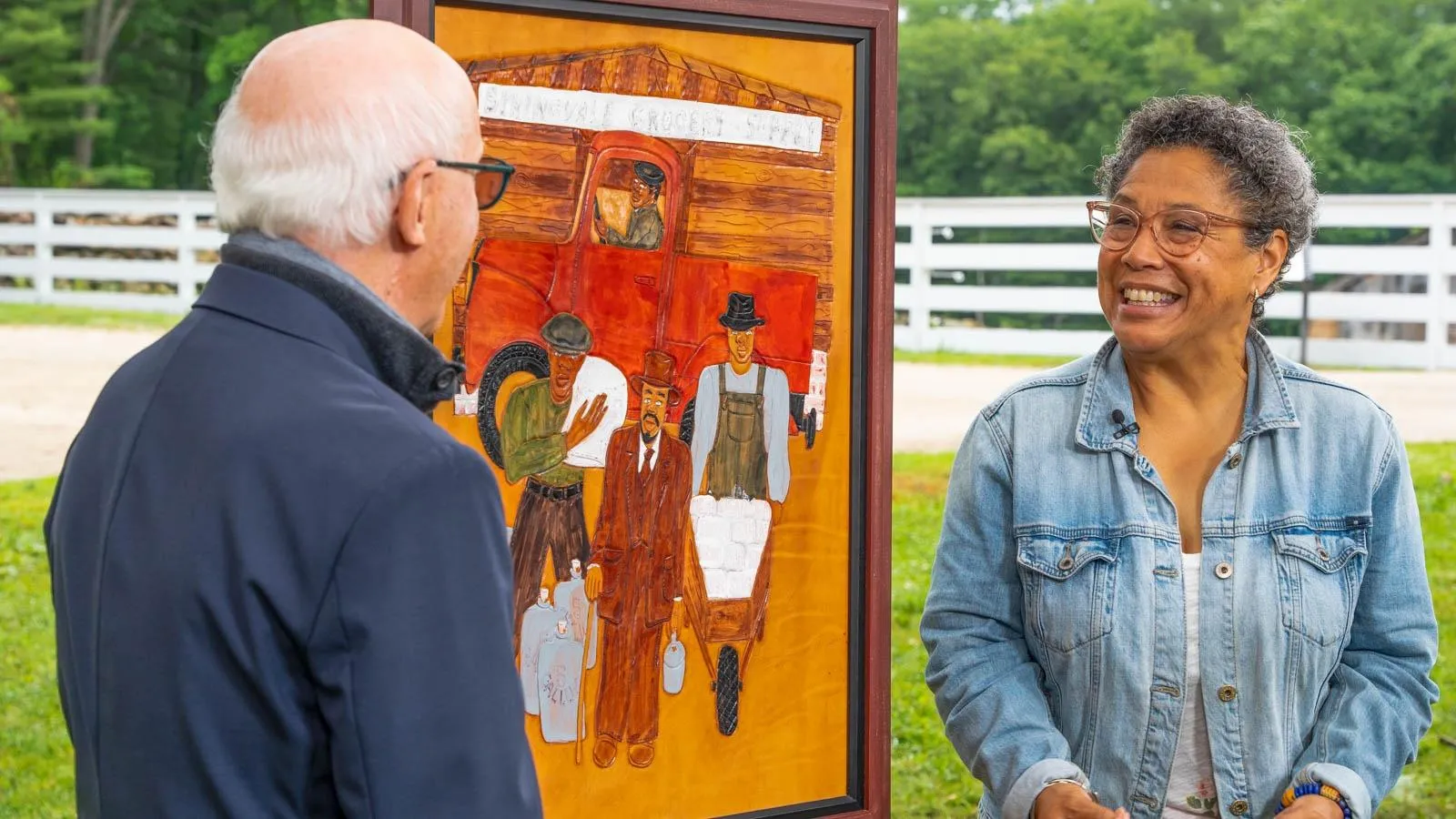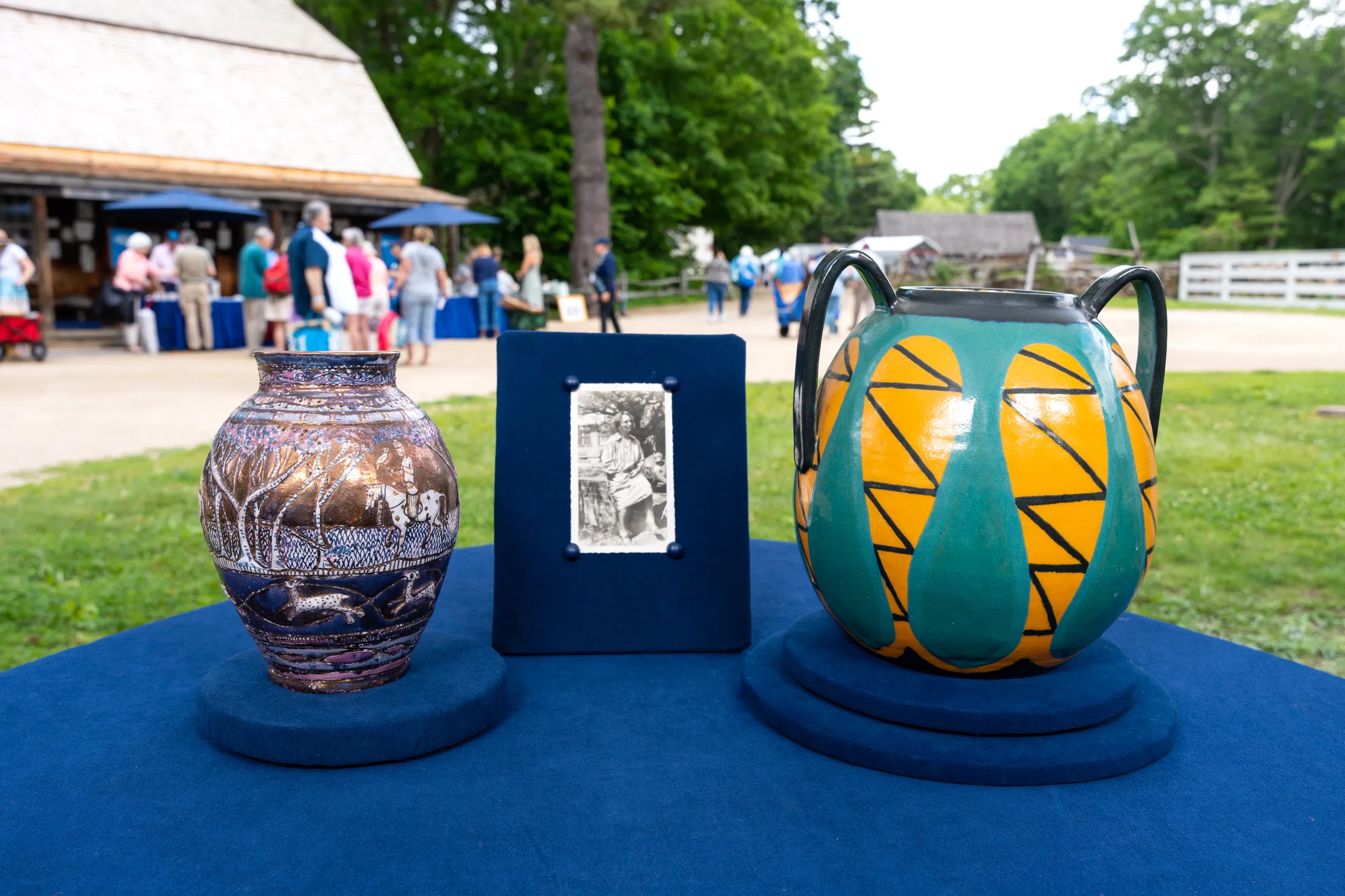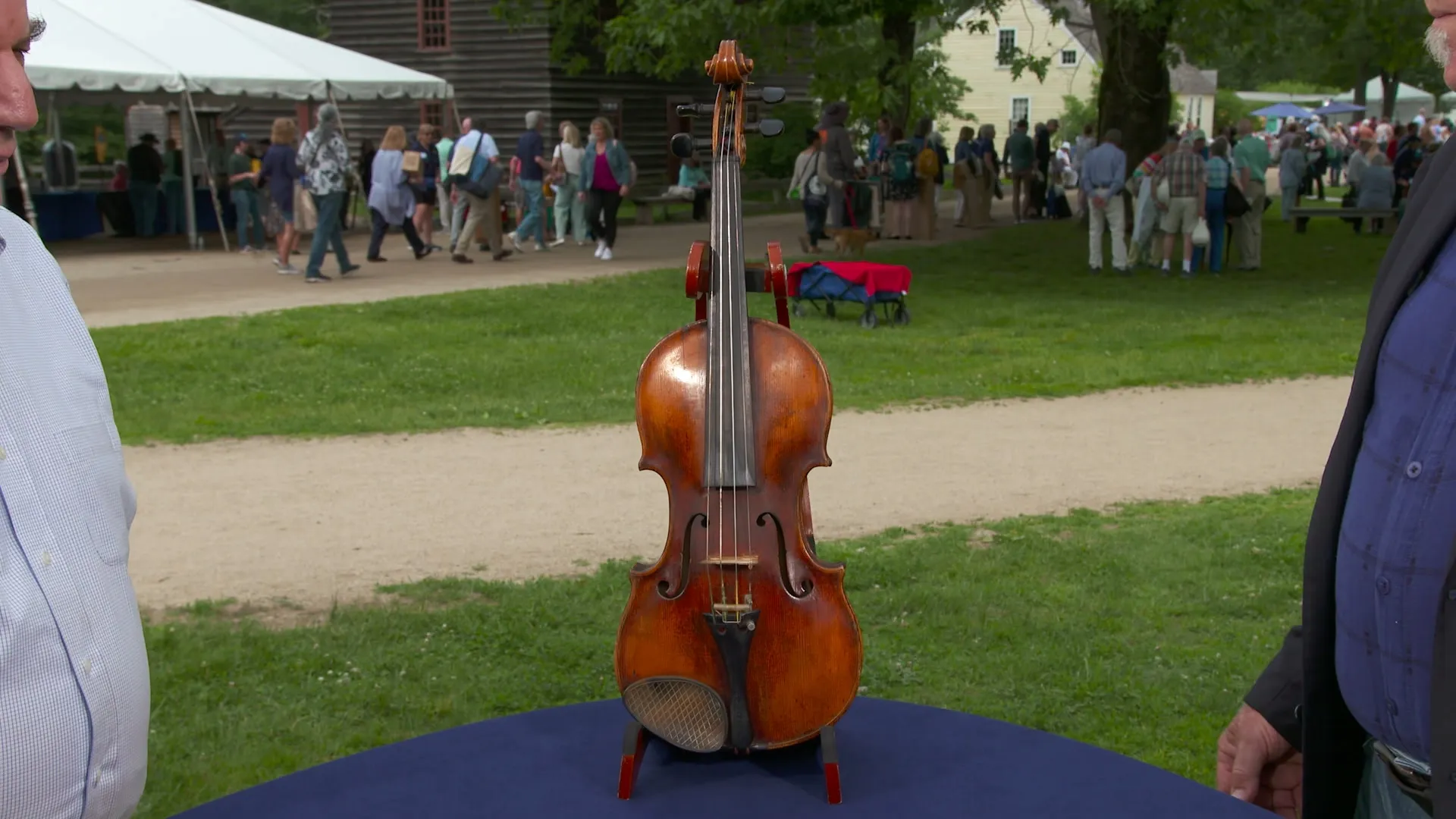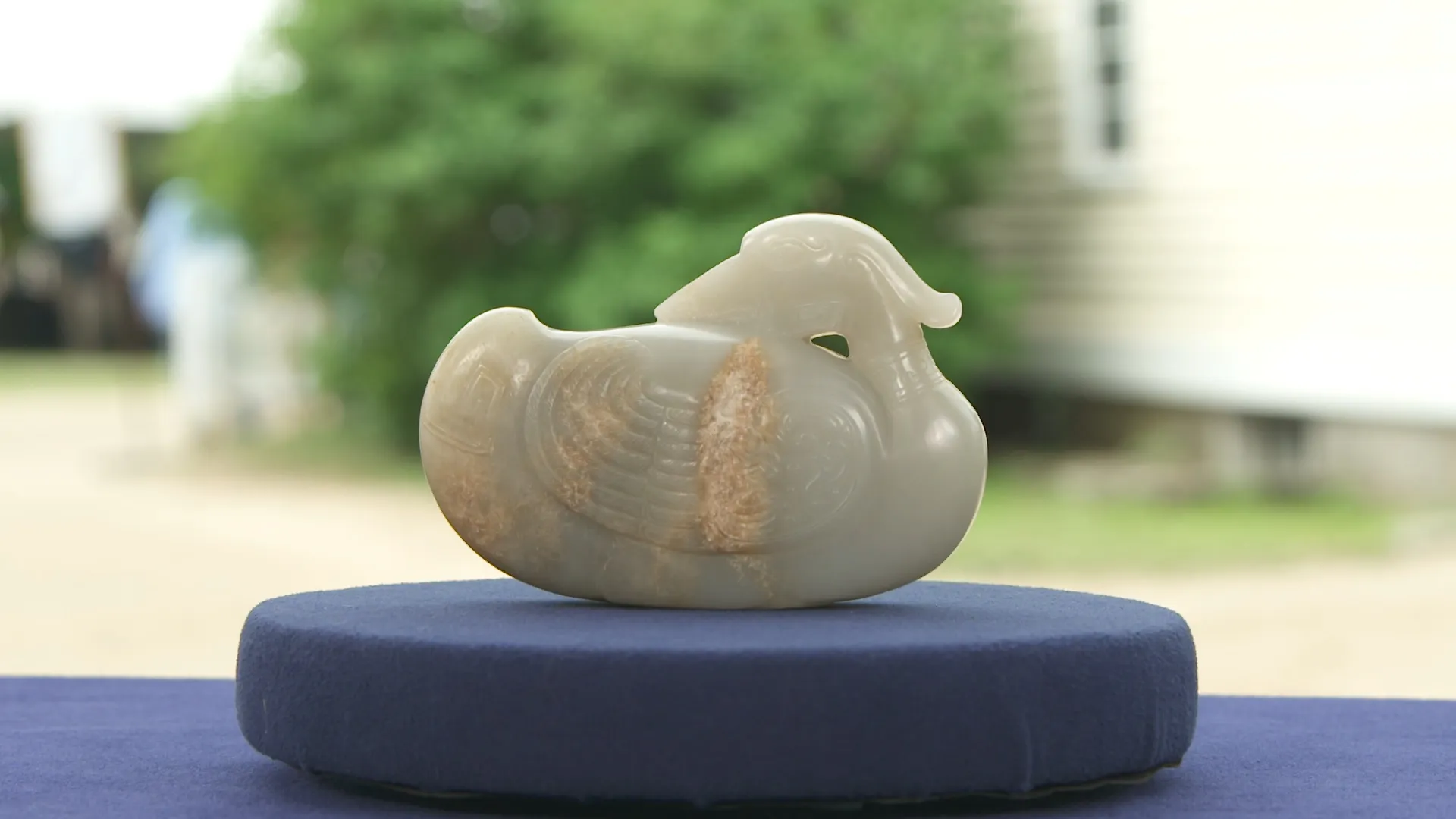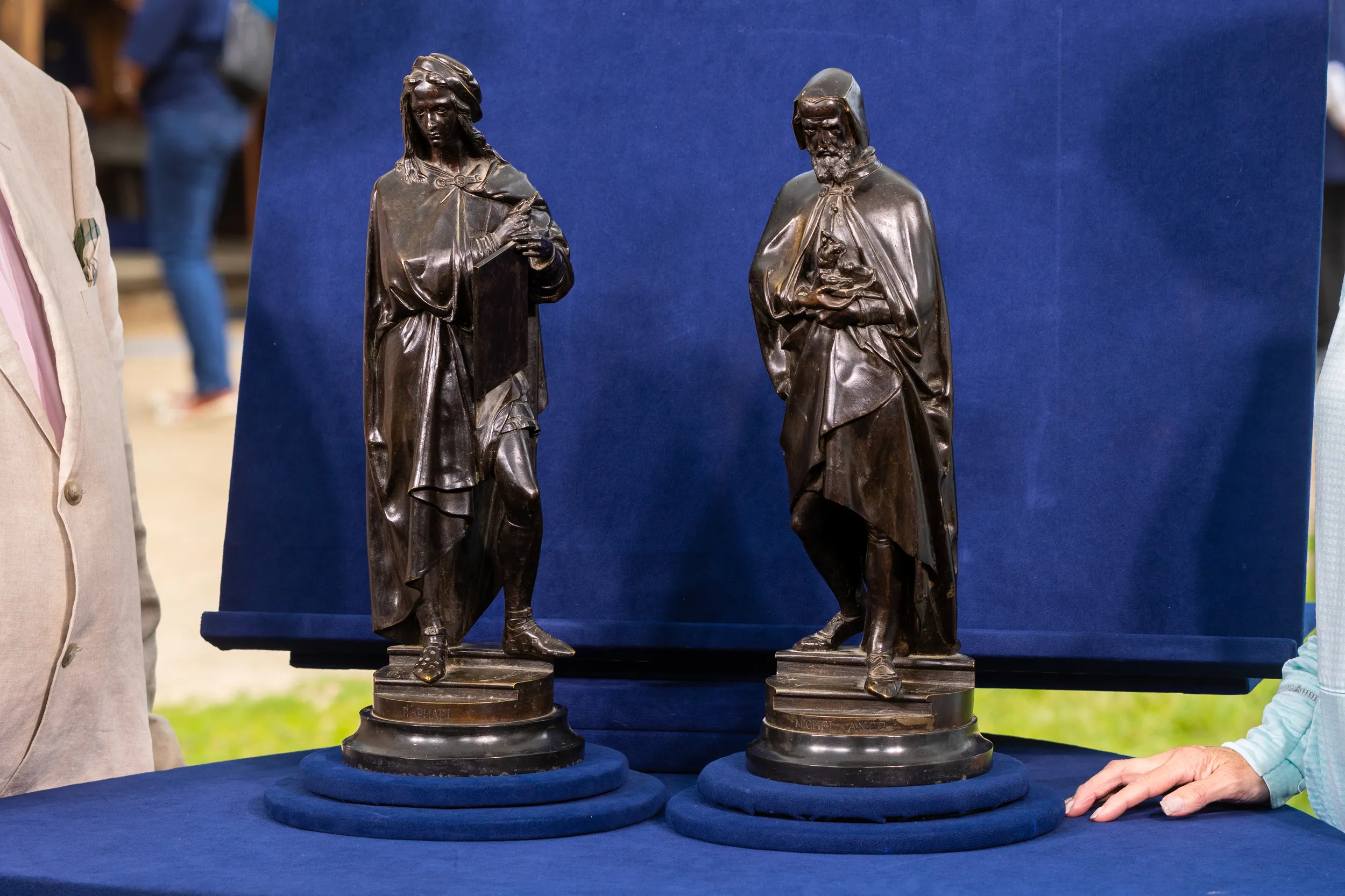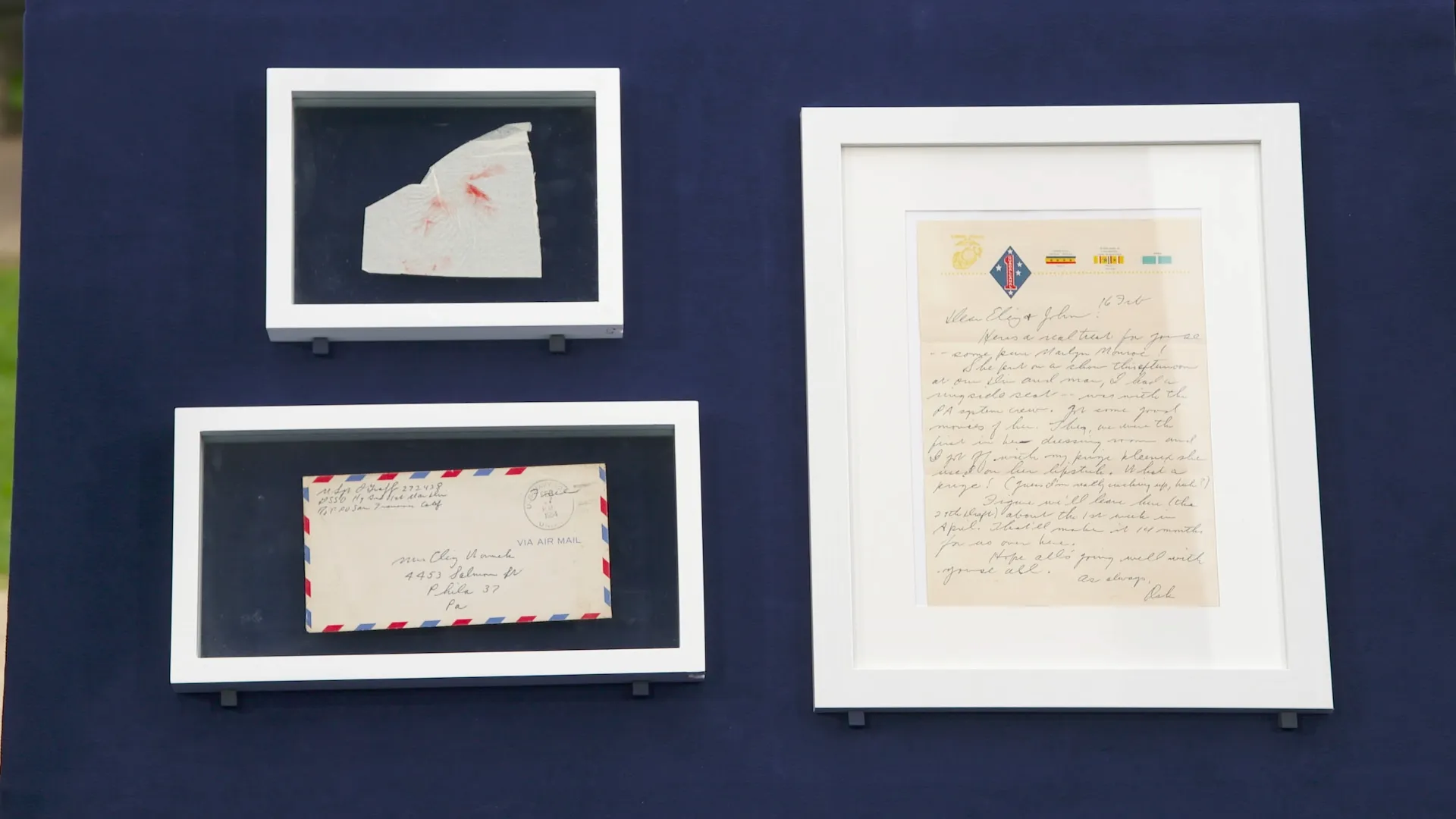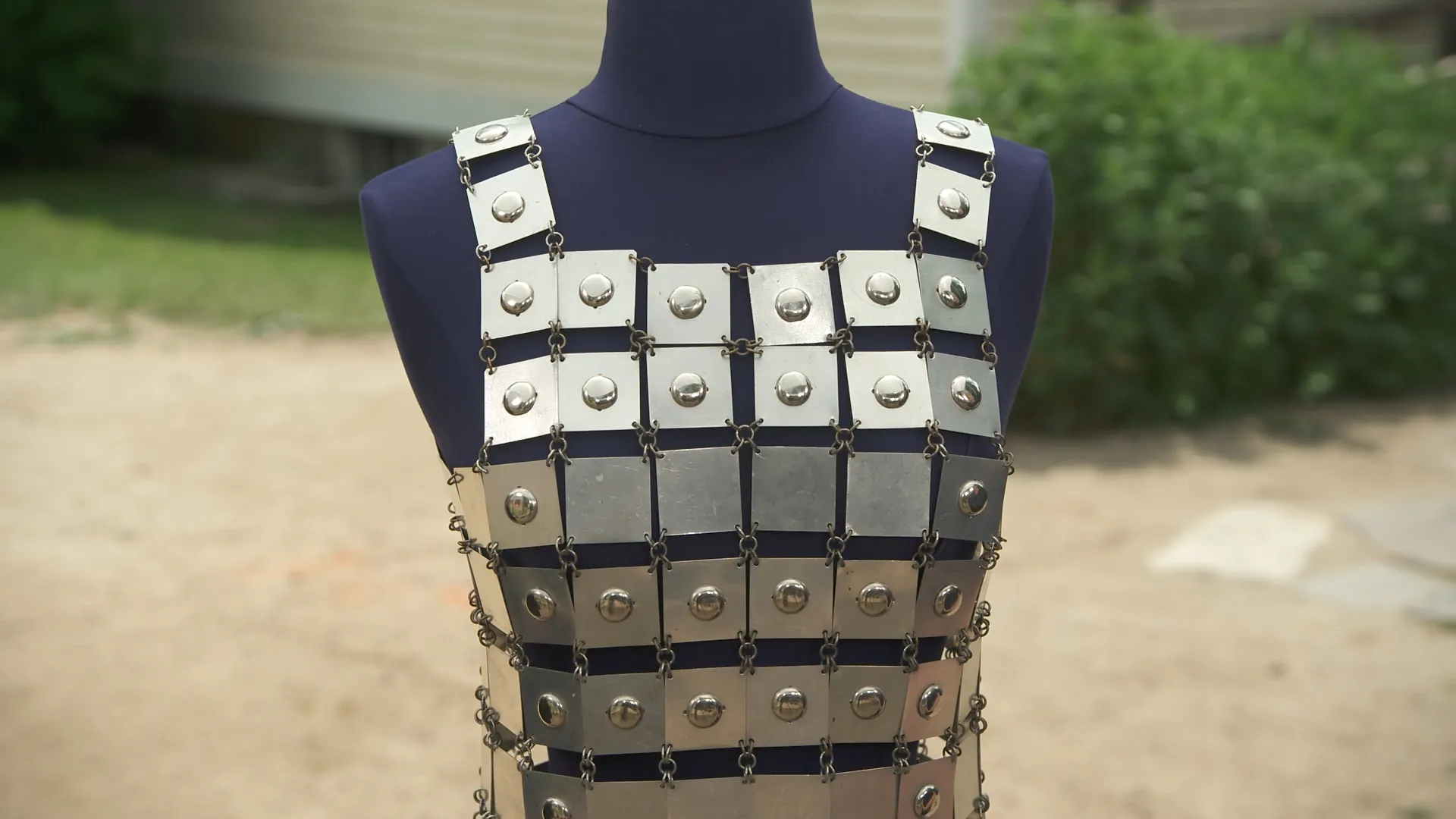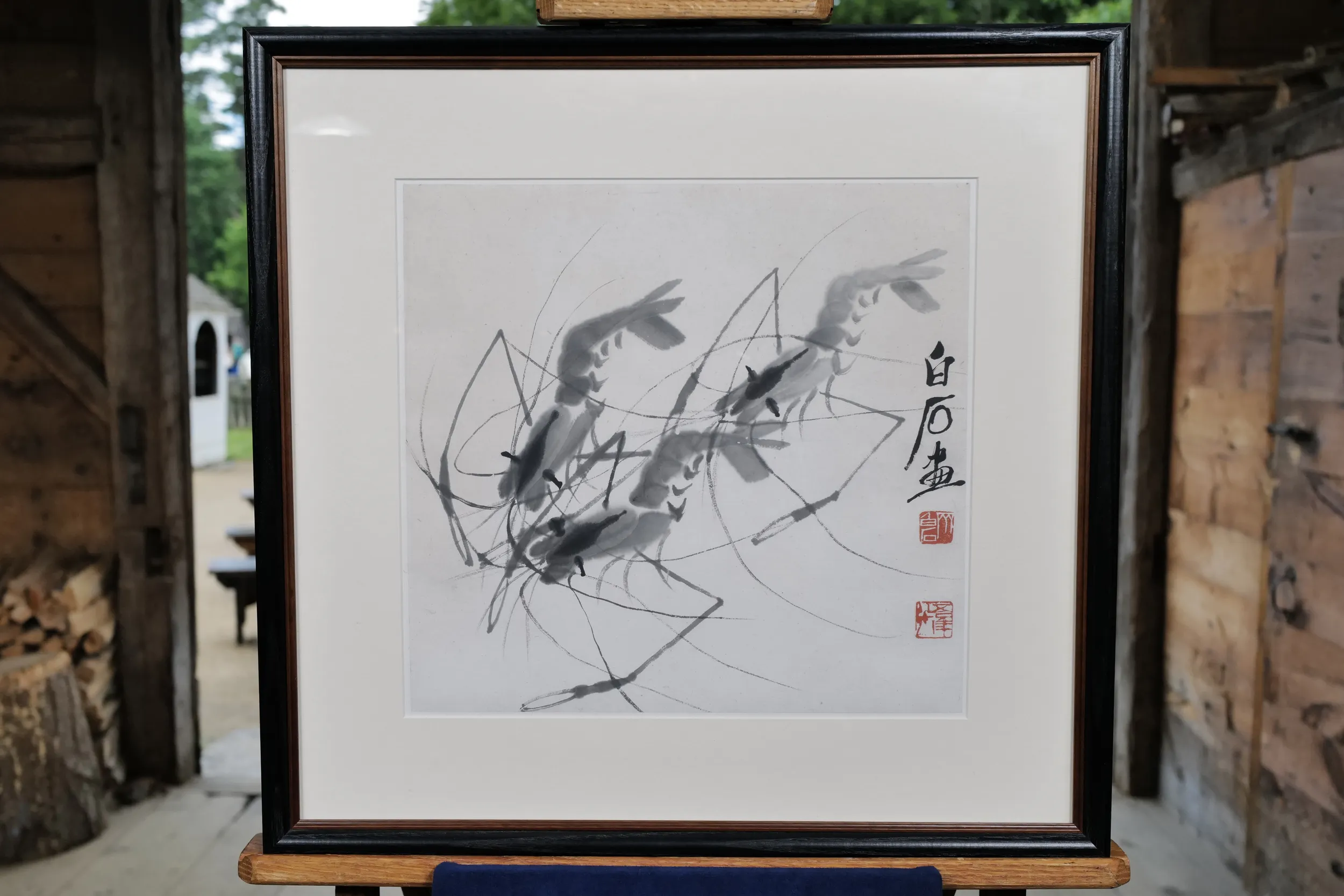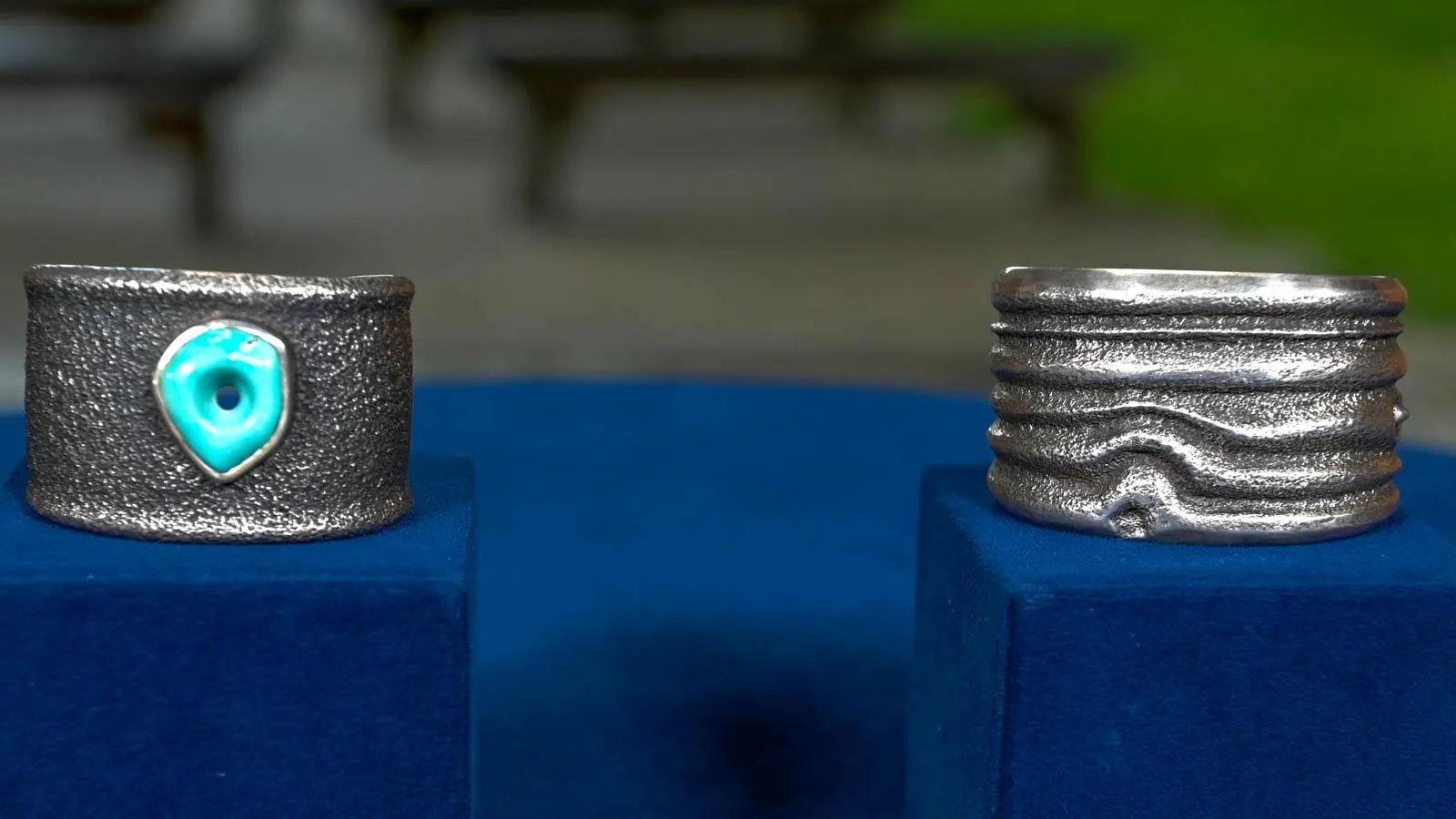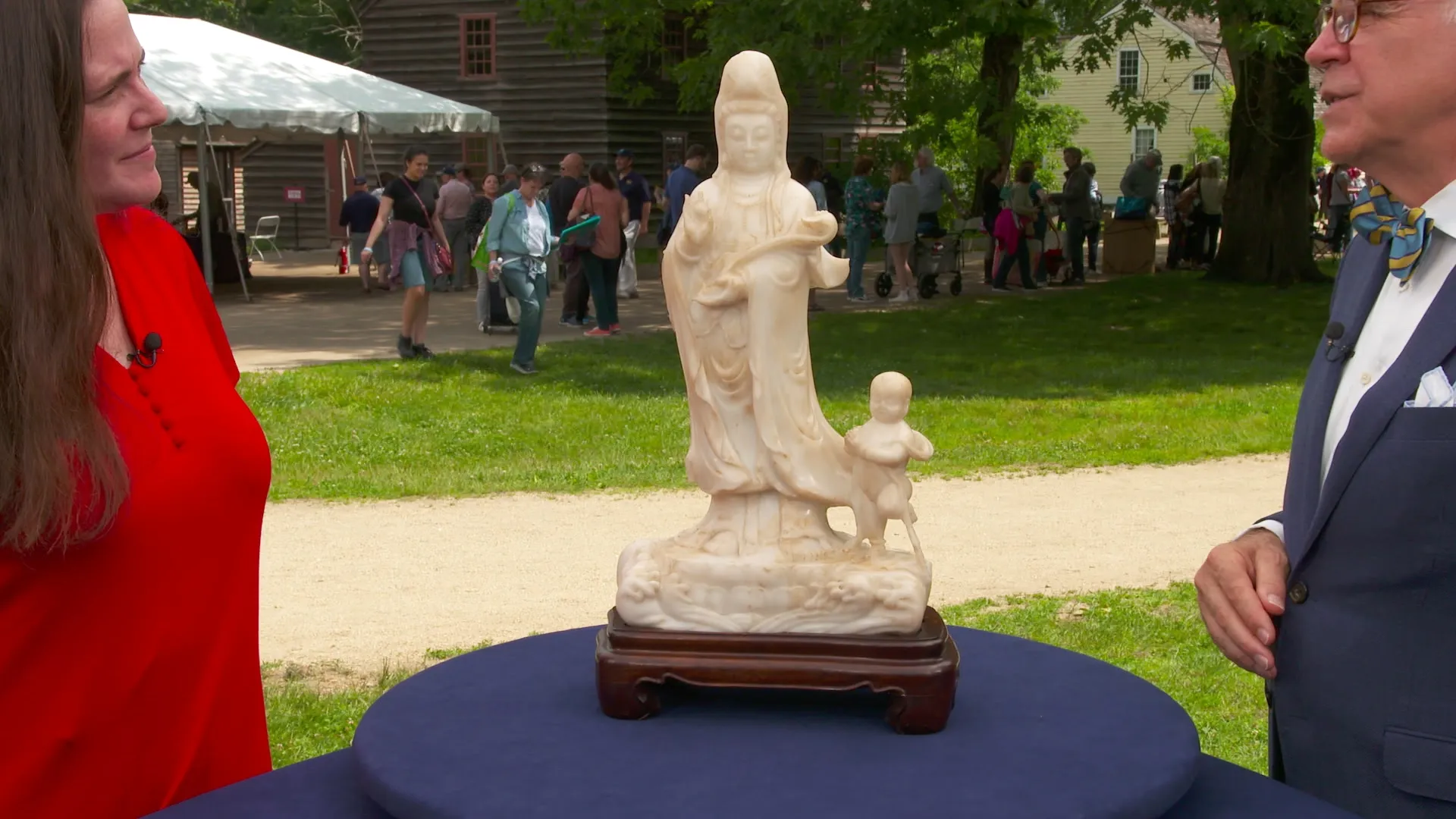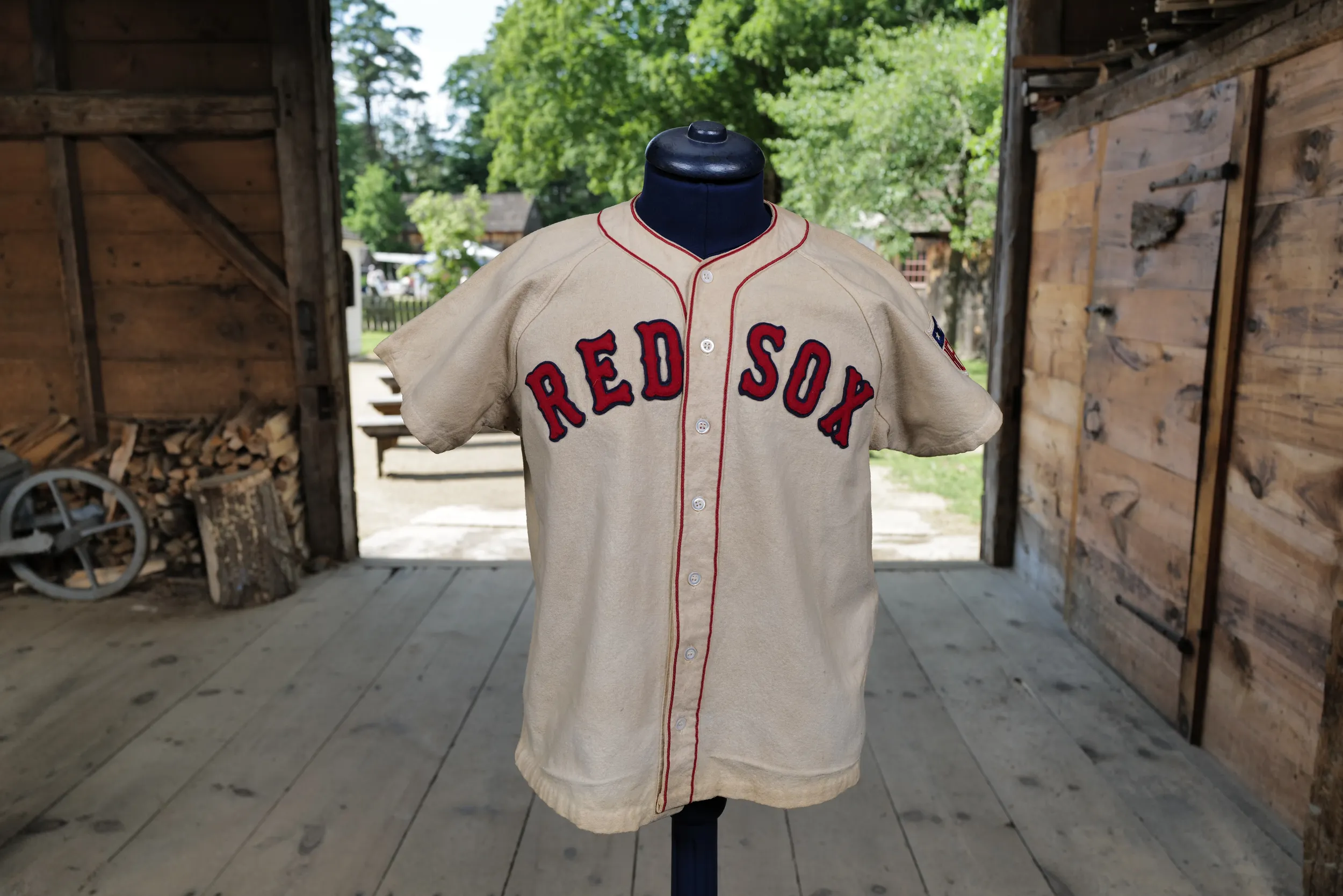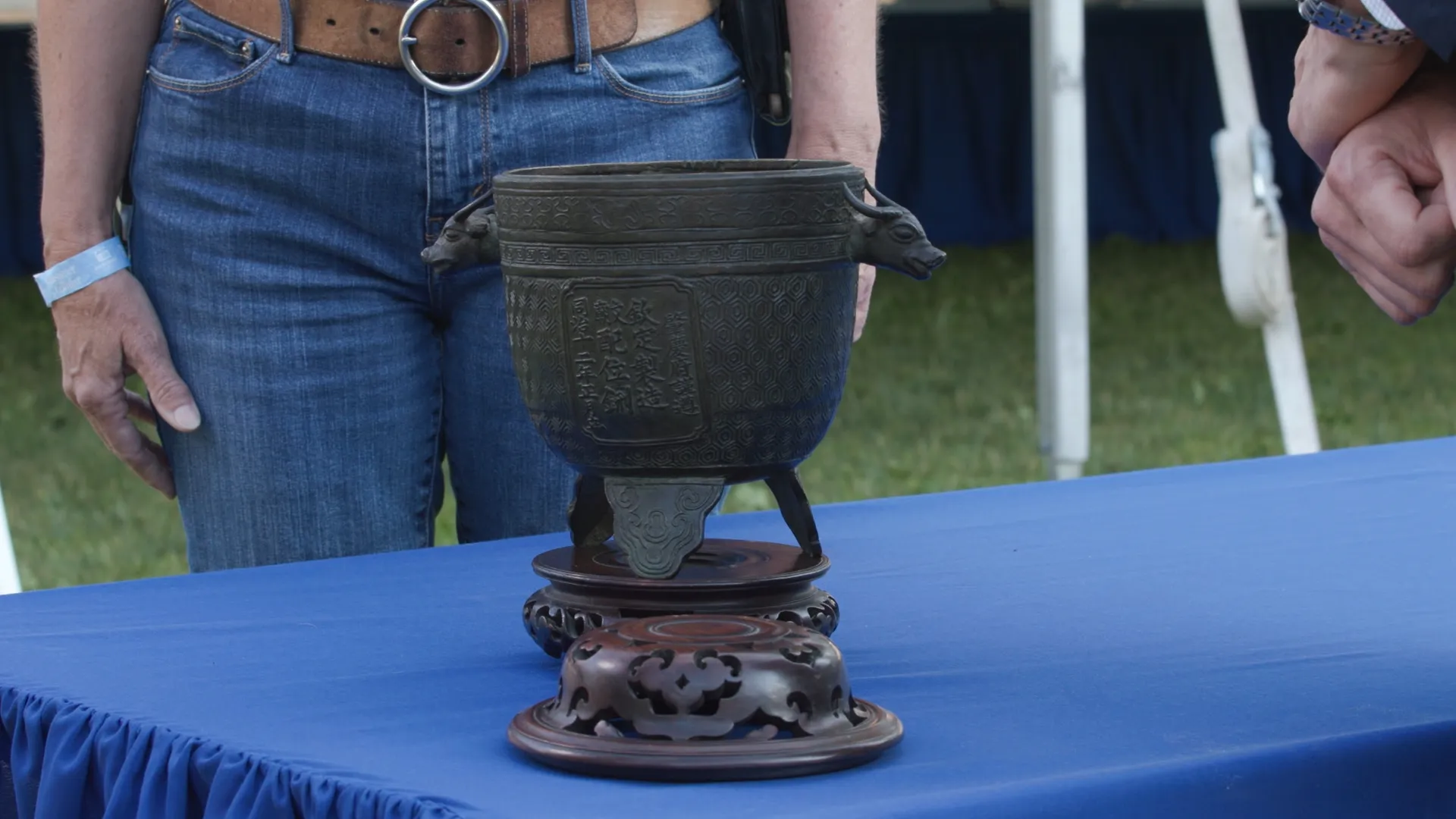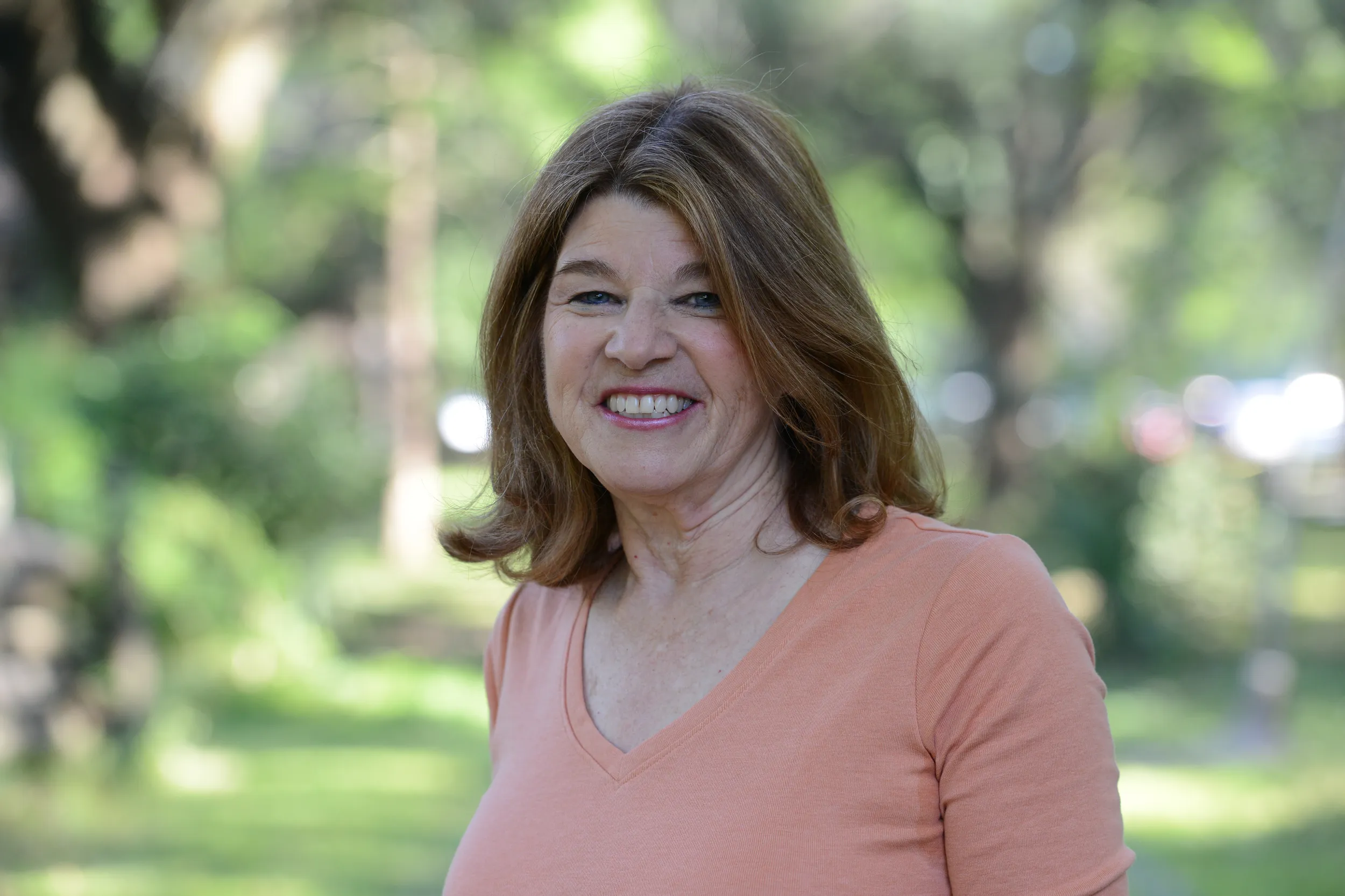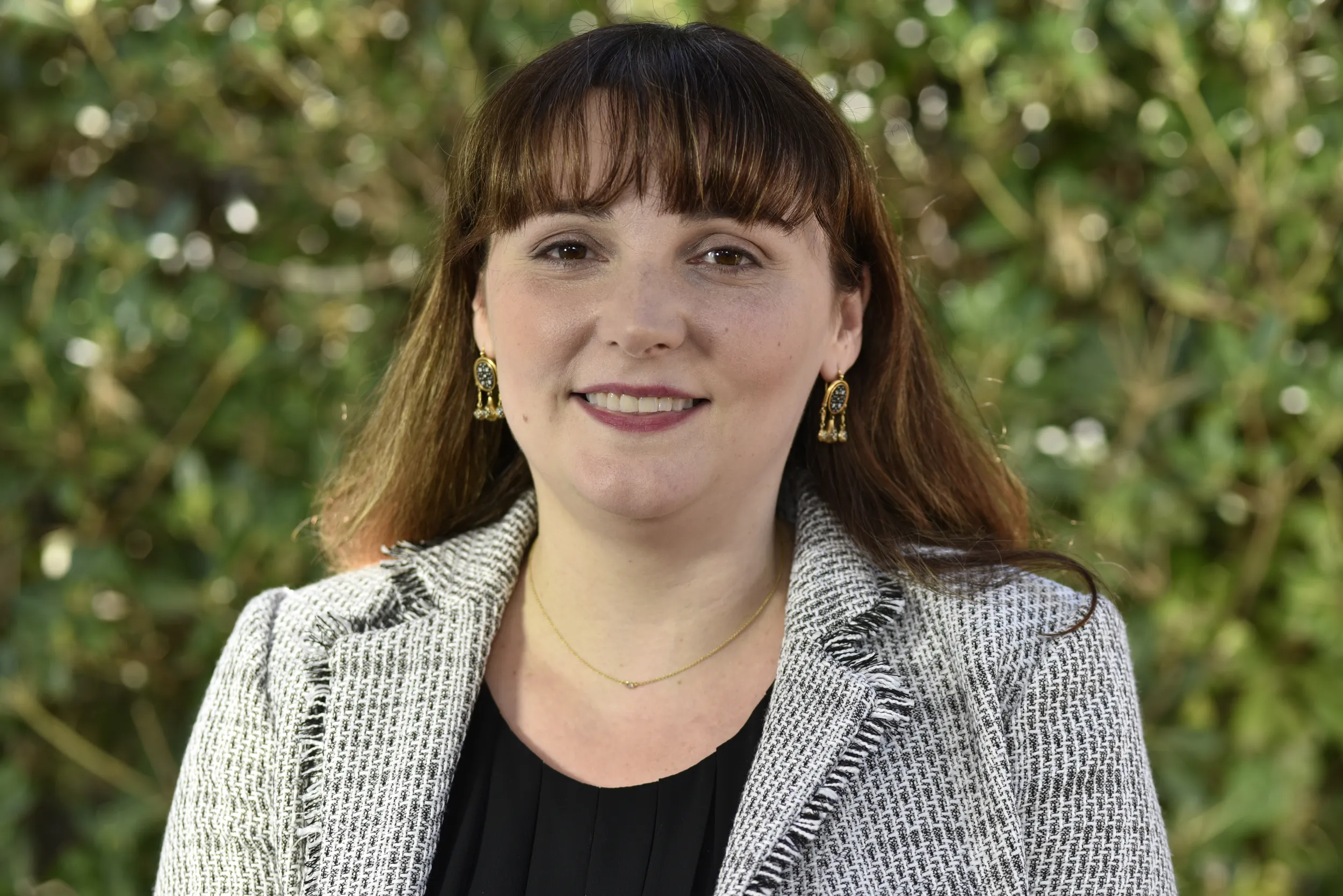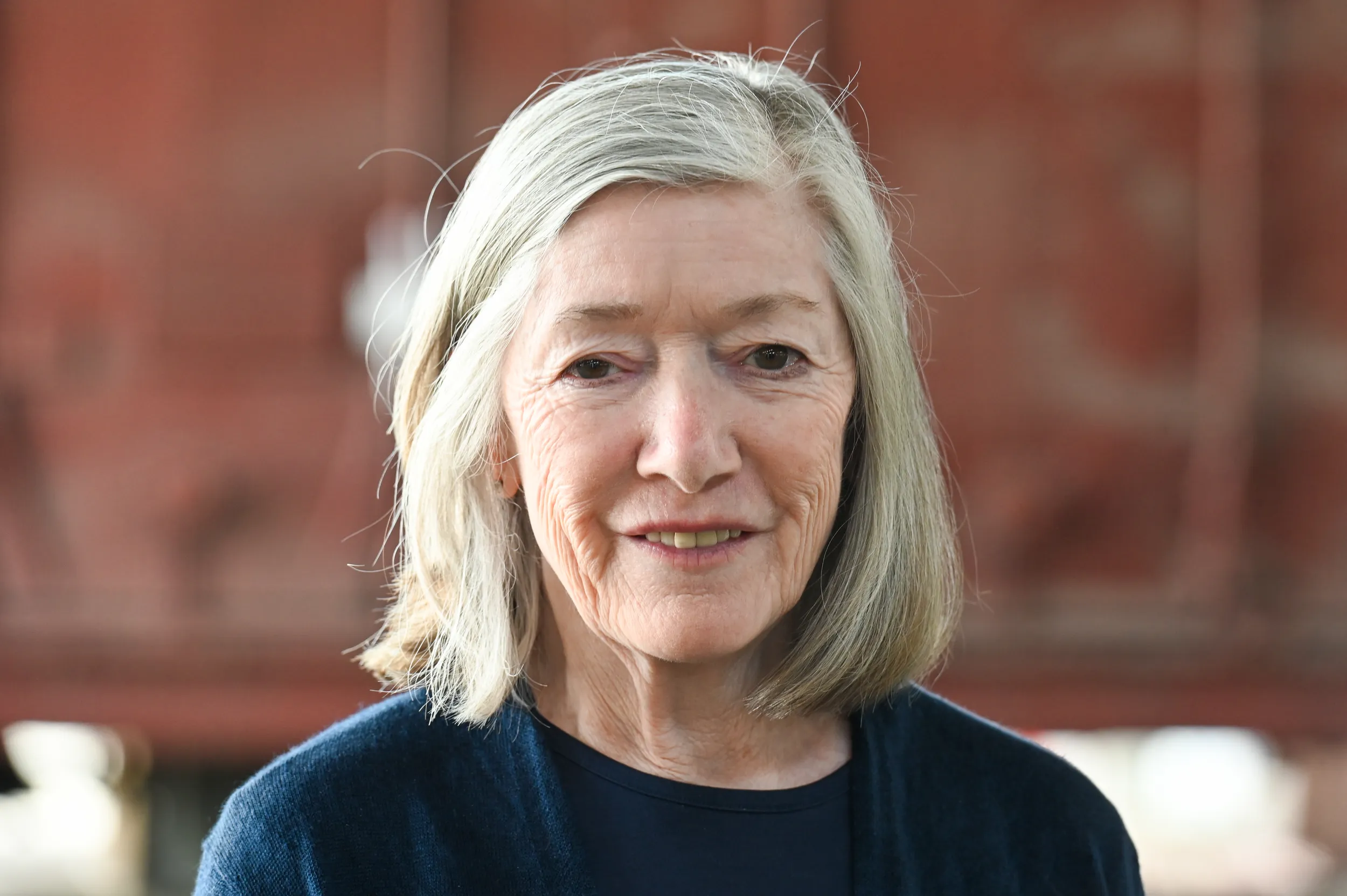HOST: ANTIQUES ROADSHOW is making new discoveries at Old Sturbridge Village, Massachusetts.
GUEST: Oh, my gosh. (laughs) That's fantastic.
GUEST: I had no idea.
GUEST: Wow. It is fabulous. I wish it fit me. (both laughing)
HOST: Old Sturbridge Village is one of the youngest old-looking towns in New England. The site was the passion project of A.B. Wells, a wealthy businessman who got the collecting bug in the 1920s. And as his hobby grew, Wells knew he wanted to share it with the world. Like any labor of love, the time and effort required to build the collection and set up the village was considerable. But, eventually, Old Sturbridge Village opened in June of 1946. Today, this history museum, set on over 200 acres with 40 buildings and tens of thousands of antique objects, transports visitors to rural New England life in the 1830s. ROADSHOW’S guests have transported thousands of their own treasures to be appraised by our experts. Let's see what they brought in.
GUEST: We were just told to come to tribal, so we expect it's tribal. We expect it's North American tribal.
CREW: Where did you get it?
GUEST: From my father, who died and told me nothing about it.
GUEST: You got it from your mother.
GUEST: From my mother, who got it from my father, who... Yeah.
GUEST: My mom passed away in 2009, and that's when I inherited it. It was given to her by her mother, and I think it might have been my great-great-grandmother's, also, I'm not sure.
APPRAISER: Mm-hmm, mm-hmm.
GUEST: But my great-great-grandparents were wealthy industrialists in Passaic, New Jersey. And I know that my grandmother went on the, uh, tour of Europe that all the fancy people used to go on. But, otherwise, I don't know anything about it. It's got a pink stone that, I have never seen a pink stone anywhere before, so I thought I'd bring it.
APPRAISER: Do you ever wear it?
GUEST: No, I wore scrubs to work, so it didn't quite go.
(both laugh)
APPRAISER: It's in the form of a star, and that form was very popular in the late 19th century. It was probably made about 1880. Now, the star form was common. What's not common is all these colors used in the star. Most of the stars that we see from this period are in pearls or in diamonds. That pink stone in the middle is a sapphire.
GUEST: Wow.
APPRAISER: A lot of people think sapphires only come in blue. But, but they come in pink, and this is just an especially great pink. It's just a beautiful, well-saturated, almost purply pink color. It's a really beautiful pink sapphire, one of the better ones that I've seen. It's about, I'd say, somewhere between two and three carats.
GUEST: Wow.
APPRAISER: And then it gets even better, because around that pink sapphire, they have put yellow diamonds.
GUEST: Oh, wow.
APPRAISER: And there's about two carats of yellow diamonds. And then around those are white diamonds.
GUEST: Wow.
APPRAISER: We did test it, and it's, tests for about 18-karat gold. The stones are old-cuts. The sapphire is an old- circular-cut sapphire, and the diamonds are old-European-cut diamonds, which were really popular in the period. Also what I like about this piece of jewelry is the back, because it's not just a brooch. It has a little retractable pendant loop that you can push up. And if you ever noticed that pinwheel shape in the back?
GUEST: Yes.
APPRAISER: If you twist that, it unscrews the whole brooch fitting so that you can wear it as a pendant without the brooch part poking you.
GUEST: Oh, I didn't know that.
APPRAISER: It's a really great piece, and it's an unusual piece. And it's in really, really wonderful condition. The only thing it doesn't have is a signature or a hallmark.
GUEST: I know. I couldn't find one, either.
APPRAISER: Which is disappointing, because would love to know who made it, or at least where it was made. My suspicion is that it is American. At auction, this would be estimated in the $30,000 to $50,000 range.
GUEST: Oh, my goodness-- really!
APPRAISER: Mm.
GUEST (chuckling): I am totally surprised. Oh, my goodness. Really? (stammers): Wow. (laughs) I am amazed. Oh, my gosh. (chuckles) That's fantastic. Oh, my gosh. (laughing) That's amazing. How much did, did you say?
APPRAISER: At, at, at auction, $30,000 to $50,000.
GUEST: Well, I better start taking insurance out.
APPRAISER: If you're going to insure it, I'd probably insure it around $80,000. (gasps):
GUEST: Wow. That is a complete surprise. (laughs) I'm shaking.
(both laugh)
GUEST: Wow, Kaitlin, that is amazing. Thank you, oh, my God. (laughing) (exhales) I can't wait to tell my daughter. (both laugh) She's gonna drop dead. (laughs)
GUEST: They've been in our family for about 100 years, and they were in my grandmother's home in Dallas, Texas. And she used to host art shows for, uh, starving artists, so to speak. And we think this is one of the paintings that was from the starving artists, but we're not sure.
ADAM: Do you display it?
GUEST: Are you kidding? (laughs)
GUEST: It was your Great-Aunt Irene, right?
GUEST: No, Arlene.
GUEST: Arlene.
GUEST: Yes.
GUEST: Who became a very, uh, well-practiced-- she was a pianist. She taught.
GUEST: Right.
GUEST: And then you...
GUEST: She, eventually, um, right, there was more to it. I thought you wanted a simple version.
CREW: That's pretty simple.
GUEST: My brother worked for U.S. Animations, who produced the first Beavis and Butt-Head episodes back in the early '90s. Uh, he was the technical director. He worked on all the, this animation. I remember him actually calling me while they were in production. They hadn't even finished, uh, and he said, "We're making this, uh, we're making this cartoon for MTV called Beavis and Butt-Head." He says, "The animation is horrible, but it's gonna be a big hit," uh...
APPRAISER: (laughing)
GUEST (laughing): And, and he was right. So he knew Mike Judge, who made, uh, Beavis and Butt-Head. They had these drawings. And he basically just went to, to Mike and said, "Do you mind if I have these?" And he said yes. "Sure, you can have this." He wasn't making a lot of money at the time. And so between my other brother and sister, he would send us stuff that he had worked on. He had sent me these pictures, as well as the, uh, the background for, the original background for Beavis and Butt-Head. This was, like, for a Christmas gift.
APPRAISER: Yeah.
GUEST: So, "Those are, that's my present for you," uh...
APPRAISER: (chuckling): What a gift.
GUEST: So, yes, it was, it was. I, I didn't even realize until much later, after it became popular.
APPRAISER: Yeah, so this is very early days of Beavis and Butt-Head.
GUEST: Yes.
APPRAISER: Yeah, okay, okay.
GUEST: Yes. This was, like, '93...
APPRAISR: Okay.
GUEST: ...uh, when they first produced it.
APPRAISER: So, as you know, it became a hugely popular series. Very much an adult show.
GUEST: (chuckling): Yes.
APPRAISER: It's one of those funny things where, usually, we talk about the main characters in this...
GUEST: Uh-huh.
APPRAISER: ...as being the heroes of the appraisal.
GUEST: Right.
APPRAISER: But here, in this instance, we're actually really gonna focus more on what we've got here...
GUEST: Yeah.
APPRAISER: ...which is the famous couch.
GUEST: Exactly-- iconic, yeah.
APPRAISER: Yeah, yeah. Possibly as important as the two main characters.
GUEST: Yes.
APPRAISER: Um, because it features so heavily in the whole show.
GUEST: Yes.
APPRAISER: It is the original couch...
GUEST: Yes.
APPRAISER: ...before it was changed.
GUEST: Yes.
APPRAISER: Now, is there any kind of history behind that?
GUEST: When I talked to my brother, I think he ob, obviously understood how important it was to the, to the background and to, uh, the show itself. After he gave it to me, he says, "I wonder if Mike Judge wants that back."
(both laugh)
APPRAISER: Well, maybe.
GUEST: But he was happy, but he was happy to give it. I mean, he, he offered to, that, he offered to give it away. And so, and he told me, he said, "Yes, this was the original couch that was used as the background," and they would scan it in. They would use it for all those episodes, and, but there was basically just one original couch. And then, as they ma, did, as they did more episodes later on, or as other, other production companies came in, there was other couches and other backgrounds made.
APPRAISER: Uh-huh. And that, and that may be the reason why the couch changed, because your brother...
GUEST: Right.
APPRAISER: ...ended up with the original couch.
GUEST: Right.
APPRAISER: Yeah. So, this is a very cool piece because it's what's called a master production background. So, it was the mainstay of much of the scenes and what was going on in the early days of Beavis and Butt-Head. So here we have watercolor and pen and ink. And then down here, we have the iconic pair that are pen-and-ink drawings. They all date from the first season of Beavis and Butt-Head in '93. This is instantly recognizable to any Beavis and Butt-Head fan. It really is.
GUEST: (laughing): Yes.
APPRAISER: And I love the, the patchwork on the...
GUEST: Right, of course.
APPRAISER: ...on the, on the wall. This piece, on its own, is worth more than these two together. Absolutely.
GUEST: Wow.
APPRAISER: We're looking at... At auction, I would not be surprised to see it sell for between $2,000 and $4,000.
GUEST: Okay.
APPRAISER: For that piece on its own.
GUEST: Wow, wow.
APPRAISER: The main characters, Beavis and Butt-Head... Uh-huh. ...um, you're looking at around $1,000...
GUEST: Wow.
APPRAISER: ...as a pair.
GUEST: Wow.
APPRAISER: So, all in all, we're looking at $3,000 to $5,000 at auction.
GUEST: Nice! That's a nice little bonus.
APRAISER: Absolutely-- a nice present from your brother. (laughs)
GUEST: Yes, it is-- I owe you, bro.
APPRAISER: I think it's the most expensive couch I've ever appraised, actually.
GUEST: I will put that in the notes-- that is awe... (laughing) That is great.
HOST: This pottery shop, built around 1819, came from Goshen, Connecticut. It was moved to Old Sturbridge Village in 1962. Farmer and potter Hervey Brooks made utilitarian redware pottery until he was 85 years old. This reproduction of his kiln holds 1,000 pottery pieces. The glaze Brooks used has an element we now know is poisonous: red lead. This flower pot is thought to have been from the last firing Brooks ever did, in 1864.
GUEST: My grandmother worked for the S.E.Gs., the Saturday Evening Girls. That was a, a group of young immigrant women, and she was one of them. She, she immigrated from Lithuania...
APPRAISER: Uh-huh.
GUEST: ...when she was about ten, at the turn of the century. And she had these pots and many, many others that I have at home. She loved it.
APPRAISER: And this is her, right here?
GUEST: Uh, yes, it is. That's right in front of the, um, pottery that moved from the North End to Brighton.
APPRAISER: Tell me about the history of the Saturday Evening Girls.
GUEST: They were these group of young immigrant women who got together initially, I think, as a reading group, to learn about books and culture. And they went on outings, practiced their English. She just said they were all so glad to be there, and to be together, and they all supported each other.
APPRAISER: It's interesting, because we've come to think of them as being pottery decorators.
GUEST: Right, that's ama...
APPRAISER: But they really didn't start that way.
GUEST: Yeah, it was only one of the things they did.
APPRAISER: Uh-huh.
GUEST: But it was a really important thing, because that was the thing they did to make money. She was a single parent. Her husband was, um, very ill and hospitalized.
APPRAISER: Mm-hmm.
GUEST: And so she had to raise two daughters. One was my mother. And she went to work for the Saturday Evening Girls, and she was a member. And then she decided she needed to make some money. And so they hired her as a bookkeeper, and she ran the office, and, um, she continued to work there for years, and she just loved it.
APPRAISER: The company was called the Paul Revere Pottery. They were in the North End of Boston, but it was really known as Saturday Evening Girls. S.E.G., Paul Revere, 1908 to 1942. It's, uh, very progressive, uh, workplace meant for, uh, young women in the North End...
GUEST: Yeah.
APPRAISER: ...who had terrible working conditions, normally.
GUEST: Yeah.
APPRAISER: But at S.E.G., at Paul Revere, eight-hour workdays rather than ten. They got a half a day off on Saturdays, which was revolutionary.
GUEST: Yeah.
APPRAISER: They had-- they were read Shakespeare...
GUEST: That's right, that's right.
APPRAISER: ...while they were working. The women who started Paul Revere Pottery were trying to bring these young women into the workforce, give them something of an education, acclimate them to American society. There are not artist initials on these pieces. Is there any chance she decorated these?
GUEST: It's possible. I like to think she did.
APPRAISER: Had I not turned these over, I would not have known these were Paul Revere Pottery. And the marking system changed from S.E.G. to Paul Revere sometime around 1925...
GUEST: Mm-hmm.
APPRAISER: ...where Paul Revere, which is the circle mark with Paul Revere riding a horse...
GUEST: Right, right, yeah.
APPRAISER: ...his famous ride, uh, usually in black ink on the bottom of the piece. They also had a die stamp mark showing the same designation. There's the original label...
GUEST: Right.
APPRAISER: ...with the Paul Revere Pottery mark and, and original price tag, the price of $75, which was a lot of money.
GUEST: Wow, that was a lot for them.
APPRAISER: So, this one only has the black stamp, which is hard to see, because this black glaze that's on the top...
GUEST: Mm-hmm.
APPRAISER: ...covers the bottom. I would date this one probably, uh, 1925, 1930.
GUEST: Mm-hmm.
APPRAISER: This one maybe about the same era. So a little later, but most unusual, 'cause this is not really what they did.
GUEST: Right.
APPRAISER: Okay? This, to me, looks like a piece of pottery that was made in England around 1880, 1890.
GUEST: Huh.
APPRAISER: It's more Pre-Raphaelite and Romantic in its iconography.
GUEST: Yeah.
APPRAISER: This piece, which is pretty fabulous, I mean, when I looked at it, after knowing what it was, I recognized the green glaze and the black glaze.
GUEST: Mm-hmm.
APPRAISER: Those are glaze that they used at the Paul Revere Pottery.
GUEST: Right.
APPRAISER: But not in this style.
GUEST: This looks like a piece of, of modern pottery made between World War I and World War II, either in Belgium or Germany. It doesn't look like a piece of Paul Revere made in Boston. So, why do they look like this? I think what we saw happen in all the art potteries from the first quarter of the, of the 20th century, either had to adapt...
GUEST: Mm-hmm.
APPRAISER: ...or they were gonna die. So what I'm seeing is that, instead of looking internally, and picking their own path to decorating ceramics...
GUEST: Mm-hmm.
APPRAISER: ...they started to look outward after World War I...
GUEST: Huh, interesting, yeah.
APPRAISER: ...and looking to England in, in this case, and looking to Germany or Belgium, in the case of this one-- most unusual.
GUEST: It is.
APPRAISER: This, by the way, appears to be, uh, hand-thrown.
GUEST: Yeah, yeah.
APPRAISER: This one is definitely cast. This even has a bit of a, a nacreous or iridescent finish to it. I don't believe the design is cast. I believe it's built up or carved back. So someone spent a tremendous amount of time on this, which is why there's a $75 price tag on it.
GUEST: Right.
APPRAISER: So, in terms of value, vases in and of themselves are difficult enough to find. To find them decorated like this, this is unprecedented. So I would say, at auction, I would estimate this piece for between $5,000 and $7,000.
GUEST: Wow.
APPRAISER: And I think, also at auction, I would have to say the same, $5,000 to $7,000.
GUEST: Wow, that's surprising.
APPRAISER: It's not what people look for. But if, but if, if this had...
GUEST: Amazing.
APPRAISER: ...a landscape design going around it, which is what they're known for...
GUEST: Right, right.
APPRAISER: ...this would be, this would be maybe a six-figure piece, so...
GUEST: Yeah. Well, that's great-- that's amazing. These are things I just played with, so...
(both laugh)
GUEST: And put dried flowers in them. So that's wonderful, thank you.
GUEST: I found this at the Goodwill maybe about five to seven years ago. At that time, I was very cheap, so it must have been ten bucks. And it reminded me of the Norman Rockwell. And so I loved it.
APPRAISER: Somebody carved an initial "M" in there.
GUEST: That was before me.
APPRAISER: You didn't do that? (laughs)
GUEST: No. But when I was young, I played the violin. And in, uh, 1958, I was invited to join the, uh, Worcester Youth Orchestra. Uh, and my great-uncle knew the director of the orchestra, Harry Levenson, who was also my violin teacher. And Uncle Abe asked Harry if he would, uh, could find a violin for me that he could give me as a gift when I joined the orchestra. And this is the violin that, uh, he found.
APPRAISER: Yeah, this is a very beautiful violin. It was made, in my opinion, by François Breton in Mirecourt, France, around 1830. Some of the things that indicate that are, well, the, how finely it was made and how nice the varnish is. Any violin that was made before 1850 would have had a Baroque, or a shorter, neck. After 1850, they modernized, uh, violins so that they could get more volume and better sound out of them. This is, uh, many steps above what the normal high school violinist is going to acquire. This violin has about the best wood I've ever seen on a violin. The flaming maple on the back is so tight, and, uh, this is as good as it gets.
GUEST: It cost my uncle $800. Mm-hmm.
APPRAISER: Well, in 1958, $800 would have been a, a significant investment.
GUEST: Yeah.
APPRAISER: Uh, uh, today, I would, I would expect this to be hanging on the wall of a, of a, a good violin shop with a price tag of between $15,000 and $20,000...
GUEST: Wow.
APPRAISER: ...at retail. So it's really a beautiful violin.
GUEST: (murmurs)
APPRAISER: And, uh, Uncle Abe is a, a good guy.
GUEST: He was a, he was very generous uncle. (chuckles)
APPRAISER: Yeah.
GUEST: Um, and the, insurance purposes?
APPRAISER: For insurance purposes, you could probably insure it for $25,000, maybe even $30,000. It's a very fine professional violin.
GUEST: Thank you.
GUEST: I know this is jade. Maybe it's from China-- it's Asian. I bought it in estate sale.
APPRAISER: Great, and was the estate sale local or...?
GUEST: Uh, local.
APPRAISER: Hm. Okay-- how many years ago did you buy it?
GUEST: Many years-- I think it's maybe ten years.
APPRAISER: Ten years, okay.
GUEST: Mm-hmm.
APPRAISER: Do you recall what you paid for it?
GUEST: Yeah, I paid $30. $30.
APPRAISER: You're quite right, it is jade. And you're quite right about the country of origin, too. It's carved in the manner or the form of a duck. There are two groups or two meanings to ducks.
GUEST: Mm-hmm.
APPRAISER: If there are ducks in pairs, it's a representation of marriage, fidelity, and the long duration of a happy marriage. Single ducks represent self-sufficiency, balance, and harmony. So it's likely that the, the original owner, many, many years ago, acquired this and, and had it on a tabletop or a curio box and reflected on self-sufficiency. It's likely that this was carved in the late Ming, early Qing period.
GUEST: Uh-huh.
APPRAISER: And the reason that you come to that conclusion that it's from about 1650 to the end of the century...
GUEST: Mm-hmm.
APPRAISER: ...is that the connoisseurs of jade and the lapidaries were quite comfortable carving white jade or pale celadon jade with highlights of russet, gray, and other imperfections. The imperfections were not really viewed as a, um, deterrent or a detracting quality from the jade. As you got a little bit later, into the 18th and 19th century...
GUEST: Mm-hmm.
APPRAISER: ...lapidaries and collectors really wanted pure white jade, the conduit between Heaven and Earth, without imperfection. And this is, uh, carved in an archaic style. So you can almost see archaic scrolls to the tail here, the eye, the carving to the neck. There's archaic C and S scrolls representing a look back to the past in its carving. It's also very typical of late Ming, early Qing carvings, so 17th-century carvings.
GUEST: Mm-hmm.
APPRAISER: Beautiful detail to the wings, where they've been incised in relief to show feathers. A really nice quality. Also, the polish is a very matte polish, very soft polish overall.
GUEST: Mm-hmm.
APPRAISER: Re, a lot of reproductions, a lot of later jades have a very high polish, a very bright polish. Do you have an idea of value?
GUEST: Mmm, I don't know. But I, I think it's maybe at least, uh, more than $30. (laughs)
APPRAISER: Yes. In an auction today, $10,000 to $15,000. (gasps):
GUEST: Oh, my gosh. So I have to buy the, the lunch, uh, for my boyfriend.
(both laughing)
APPRAISER: Well...
GUEST: Oh, I ne, never think about it, that, that, uh, it's so much. (laughs)
HOST: The Asa Knight store was built around 1810 and has some later 19th-century additions, evidence of the Knights' growing business success over time. Part grocery, part hardware store, and part raw materials hub, this type of store was the trade center of its community. Originally located in Dummerston, Vermont, the store carried items from around New England, as well as goods like sugar and textiles from the world beyond. The store found a home here in 1972.
GUEST: Well, my grandfather owned a moving business in Springfield, and he probably acquired 'em in the '50s. Someone couldn't pay their storage and moving bill, so he said, "Do you want these?" And my grandfather said, "Yes."
APPRAISER: Mm-hmm.
GUEST: And brought 'em home to my grandmother. And that's where they've been ever since. And that's everything that I know about 'em, except they're very heavy. They were just sitting on the fireplace in, you know, in the room with the couch that nobody ever went into. (laughs)
APPRAISER: (chuckles) Uh, they're two wonderful sculptures, and they're signed "A. Carrier," Albert Carrier. But he, later in his career, he used his, uh, family name, Carrier-Belleuse, so he's sometimes called Carrier-Belleuse.
GUEST: Mm-hmm.
APPRAISER: And he was born in 1824. And he had a classical French, uh, academic training at the École des Beaux-Arts. And he was very, very successful as a, uh, as a sculptor in many, many public commissions. He's particularly interesting because, uh, for a while, he worked in England at the Minton's, uh, Works, and he designed porcelain for Minton's. And later in his career, he was actually the artistic director of Sèvres. Uh, he was there for a number of years, and he actually died in, in, in Sèvres.
GUEST: Okay.
APPRAISER: And he was a really leading artist of his day. He did a var, a series of sculptures, and these are two rather famous people from the Renaissance. Here we have Michelangelo, and here we have Raphael. I like Michelangelo here. He's holding this little sculpture, and Raphael has his pen or pencil ready. What's particularly nice about these is, they're from the mid-19th century. And the French at that time were f, fabulous casters, uh, of bronze. So the, the casting was incredible. These also had to be finished, they had to be filed, they had to be chased, uh, when they came, they're pretty rough when they came out of the mold, and then they had to have a patina put on it. And what's really amazing about your pieces is, they have the original patina. Nothing's been happened, they're not rubbed, they're not, nothing's broken. So they're really in quite, quite good condition. Again, the detailing is, is spectacular. All the small details here, uh, and right down to the shoes, these wonderful little pointy shoes. They're really quite lovely. Uh, and again, the quality, the condition is just superb. So, hopefully, the only thing you do is dust them off?
GUEST (chuckling): I just wiped 'em down with a paper towel last night, 'cause they were sitting in the same spot for 15 years. (laughing)
APPRAISER (laughs): And have you ever had them valued?
GUEST: Never.
APPRAISER: Mm-hmm.
GUEST: They've just been the two statues.
APPRAISER: They're really wonderful examples. They're, they're sort of the best quality of French sculpture in the middle part of the 19th century. Unfortunately, it's not a particularly popular collecting field. So even though, um, uh, Carrier-Belleuse was one of the absolute leading, um, sculptor of his period, and one of his claims to fame is that Auguste Rodin...
GUEST: Okay.
APPRAISER: ...was his assistant...
GUEST: Ooh.
APPRAISER: ...for about six years.
GUEST: Okay.
APPRAISER: So, that's, that's given him the visibility. In terms of the value, at retail or for insurance purposes, for the pair of these, in the $10,000 to $12,000 range.
GUEST: Wow.
APPRAISER: (laughs)
GUEST (laughing): That's great. They're gonna be passed down to my daughter. She has a fireplace to keep 'em on. (laughs)
GUEST: And does she like them?
APPRAISER: She's never seen 'em, and so it'll be a surprise. (laughs) She lives in a very old house, and she's very old-soul, and it, it'll be perfect.
GUEST: It belonged to my grandfather, who fought in World War I. So, you take the top off, which is a cocktail shaker, and the fuse is the top. And so you put in your ingredients, you shake your cocktail, and then you strain it into one of your cocktail glasses. On the bottom, it says it's a replica, but it feels like the sort of thing you kind of want to let your local police department know you have.
GUEST: This is a letter that was sent to my paternal grandmother from her brother during the Korean War. Uh, he was stationed there in 1954. And, as the letter goes into, he was... Made into the dressing room and made off with this Kleenex that Marilyn Monroe wiped on her lips.
APPRAISER: Very cool.
GUEST: Yes.
APPRAISER: (laughs): So, you... You have the letter, you have the original envelope...
GUEST: Yes.
APPRAISER: ...that the letter was sent, and you have the tissue with lipstick on it of Marilyn's. That's-- we can't bury the lede here, it's Marilyn Monroe's lipstick...
GUEST: That it is.
APPRAISER: ...that we're looking at. We have this letter here that's from your relative. It says, "Here's a real treat for youse, "some pure Marilyn Monroe! She put on a show this afternoon at our Div." Division.
GUEST: Division.
APPRAISER: (murmurs) Yes, "And, man, I had a ringside seat. "Was with the P.A. system crew, "got some good movies of her. "Then we were the first in her dressing room, "and I got off with my prize, "Kleenex she used on her lipstick. What a prize! (Guess I'm really cracking up, huh?)" This letter is everything. So what's interesting is, this is on his official stationery, and we have all of the signifiers that make sense for 1st Marines Division, which is what he was in.
GUEST: Okay.
APPRAISER: And when I first saw Marilyn Monroe's lipstick on tissue paper, I said, "Yeah, right-- no way."
GUEST: Really? Okay.
APPRAISER: Like, "I don't believe it for a sec... "There's no way you can prove that. What, do we have DNA in here?" And then I saw the letters. (laughs): And I went, "Holy cow, we can prove it," because he wrote it the day that she arrived...
GUEST: Yes.
APPRAISER: ...for the very first show. So, we know that, and we know that it was actually postmarked the day after, so he mailed it. He, he put it in the envelope, he immediately mailed it home. And everything checks out with this story.
GUEST: Oh, wow-- yeah.
APPRAISER: So, I believe it. And I also did some digging and looked to make sure.
GUEST: Mm-hmm.
APPRAISER: Marilyn arrived on February 16, 1954. Yeah. She did four days of shows, ten shows, sometimes multiple shows on the same base. She would, was flown around Korea on helicopters. They had a team of ten helicopters that were flying the whole setup around.
GUEST: Mm-hmm.
APPRAISER: And she entertained over 100,000 troops in four days. In July of 1953, the armistice had already been signed, but we still had over 225,000 soldiers stationed in Korea as an occupying peace force. So when Marilyn was on her honeymoon with Joe in Japan...
GUEST: Mm-hmm.
APPRAISER: ...and she was asked if she'd come and entertain some troops, they kind of worked her into the show. And she sung "Diamonds Are a Girl's Best Friend," "Somebody Loves Me," and "Bye-Bye, Baby." So her part was only 15 minutes of an hourlong show.
GUEST: Yeah.
APPRAISER: But it left an impression on these soldiers that I'm sure lasted a lifetime. (chuckling): And clearly it left an impression on your relative.
GUEST: Yes.
APPRAISER: So you believed it to be true, I mean...
GUEST: Yeah, yeah, I do.
APPRAISER: The only issue that I had that I wanted to make sure it was definitely her is the fact that she was the only female performer in the show, and she was.
GUEST: Okay.
APPRAISER: A lot of Marilyn's lipsticks have actually come up for auction. Oh. And she wore some really fun, bright colors.
GUEST: Mm-hmm.
APPRAISER: She had something called Pink Spark...
GUEST: Oh.
APPRAISER: And Bachelor's Carnation. So who knows if we could match this to what shade she may have been wearing in Korea?
GUEST: That's true.
APPRAISER: But to me, this is the most extraordinary artifact, because it survived. It was never meant to. And the fact that your relative picked it up and sent it home, preserved it, and to have anything connected with Marilyn's performance there is pretty extraordinary, in my mind.
GUEST: Oh, I totally agree, it's amazing.
APPRAISER: So, now we're left with, what's it worth? I mean, this is a single-ply, military-issue tissue. This is not a luxurious item.
GUEST: (laughs)
APPRAISER: But because Marilyn touched it, and her lipstick's on there...
GUEST: Mm-hmm.
APPRAISER: ...I think, conservatively, an auction estimate would be at least $3,000 to $5,000.
GUEST: Oh, wow.
APPRAISER: And I can't imagine that there wouldn't be some Marilyn collectors who would definitely compete for that, because it's such a unique artifact.
GUEST: Yeah-- that's amazing.
HOST: Costumed interpreters at Old Sturbridge Village have expertise in many trades, crafts, and domestic tasks. Watch and learn as wool is spun into yarn, or see tinsmiths manipulate metal into utilitarian wares. The Industrial Revolution in the U.S. had already begun by the early 19th century, but much was still done by hand at this time.
GUEST: This dress was, um, originally owned by my mother-in-law. Mm-hmm. And I don't know if she purchased it in the '60s, but it's probably somewhere '60s, '70s, when she acquired it.
APPRAISER: Mm-hmm.
GUEST: And she wore it...
APPRAISER: Mm-hmm.
GUESS: ...with a, a leather dress underneath.
APPRAISER: Oh, wow.
GUEST: Yeah.
APPRAISER: That's interesting, that she wore it over a dress.
GUEST: She did, yep, yep. Okay. It's a little revealing, so... (laughs)
APPRAISER: Well...
GUEST: Otherwise.
APPRAISER: Yeah. So, this is a Paco Rabanne dress, made in France at the end of the '60s, when the space race was sort of propelling fashion, and they were looking for different fabrics and textiles and metals to incorporate into the clothing design. And the squares are made from aluminum, so that it's light enough to wear, held together by all of these small chain links.
GUEST: Yep.
APPRAISER: Most people wore this without a leather dress underneath.
(both laugh)
APPRAISER: Some of these squares have these round dots on, decorative dots, in the front, and they do follow all the way around at the hipline and all the way down. Again, they repeat the pattern up and down over the shoulders. And as you can see the mannequin right through it...
GUEST: Yep.
APPRAISER: ...it could be quite revealing. At the center back, where, on a fabric dress, you would have a zipper down the middle, in this one, the closure is these large hooks, which are like a, a jewelry or a necklace closure used to get in and out of the dress easily. And it's, it's just in wonderful condition. If I could find one of these, I'd be so happy. (laughs) And I would put a retail value on this dress of $12,000 to $15,000.
GUEST: Okay, okay, wow.
APPRAISER: And it's just fabulous. (laughs)
GUEST: Wow, it is fabulous. Yeah. I wish it fit me. (both laugh)
GUEST: It was handed down to me by my father, and it was handed down to him by his father. My grandfather, in, uh, 1913-14, was recruited by the Chinese Maritime Customs Service and worked in China, uh, generally overseeing all the maritime activities on both the Yangtze River and other rivers. This is the medal that was pinned on my grandfather, which was the medal given to the employee who became inspector general of Chinese Maritime Customs. And my grandfather was the last, uh, foreigner to be inspector general. After that, when he retired, it was a Chinese, uh, that was hired to be inspector general. So basically, he was a bigwig. Uh, a... He was a bigwig, he was at the top-- pretty much the top, um, foreigner in the Chinese government. My grandfather knew someone in the service who had purchased this painting directly from the artist, Qi Baishi.
APPRAISER: The reason that that's so important is because there are a lot of Qi Baishi, uh, drawings that are inauthentic-- there are a lot of forgeries. Shrimp were one of his favorite subjects. Here he does them masterfully. When you look at it very closely, you can feel the resilience of the water around them. You can feel the buoyancy, you can feel the movement. He painted very deliberately, very slowly. Now, if you look at the bodies of the shrimp, for example, their bodies are translucent, but the heads are, are painted in a darker color. And if you look at their whiskers, they seem to be randomly floating around, but they're really not. They s, they are adding movement to each and every single f, figure. His paintings and his drawings are deceptively simplistic, but they're perfect examples of xieyi, which is this philosophy of drawing one's feelings, drawing one's thoughts. There's one, um, philosophy called gongbi, which is doing more realistic representations.
GUEST: Uh-huh.
APPRAISER: Then the other one is xieyi. So, in a way, that's more like Impressionism.
GUEST: Uh-huh, okay.
APPRAISER: Uh... He was born in Hunan Province in 1864, and he lived a very long life until, um, until 1957. So he died when he was in his 90s. And some people consider that his best work came as he got older and older and older, 50s, 60s, and 70s...
GUEST: Mm-hmm.
APPRAISER: ...where he really started getting this beautiful, uh, translucency. He probably painted it around 1948, which would make him about 84 years old. Have you ever had it appraised?
GUEST: I never have, no.
APPRAISER: Okay. Well, I would be very comfortable placing an auction estimate on this drawing at $30,000 to $40,000.
GUEST: You're kidding. Seriously? Wow. Gee. God, I had no idea. Wow, that's amazing.
APPRAISER: If you were to insure it, I would insure it for at least $70,000.
GUEST: (inhales) That's amazing. Wow, what a gift to be given.
GUEST: So this is a Quaker wedding certificate from 1723, my husband's sixth great-grandmother and sixth great-grandfather from Nantucket. The, uh, men signed on one side and the women signed on the other.
GUET: Well, it was for some number of years in an attic, and then for the next number of years, it's been in my basement. So, I got the chair from a cousin, um, who was moving and just was getting rid of it, so I took it home.
GUEST: I believe it to be Japanese. The motors are Japanese. It's electric, runs on nine D cell batteries. I bought it at a garage sale about 15, 18 years ago. I've had it on display in my kitchen since then, uh, but with the display stand under it, and, uh, I collect toy boats, so I saw it, I had to have it.
APPRAISER: I like the way you made this little wavy display. It sort of lifts it up so you can really see it well, 'cause on the hull, it's a little wobbly. It's Japanese, it was made postwar, which means in the late '40s, early '50s, when Japan was trying to make a lot of stuff to sell to, to get out from under the debt of World War II. There's really no known maker. This is really exciting. This is as big a Japanese wooden boat I've ever seen.
GUEST: Oh, wow.
APPRAISER: It's just incredible. And it has just incredible detail and incredible condition-- as you know, condition is everything.
GUEST: Yes.
APPRAISER: Along with the wood, of course, we have these wonderful little lifeboats, ten, all in stamped tin. What's really interesting is that you have all of them, and that's what really helps make this a really incredible piece. Other metal components are the railings. And it's nice that they have quite a few little lights here that are part, illuminate while this boat is whipping through the waves. (chuckles) And I'm sure, as you know, um, uh, as a boat collector, that completeness is very, very important.
GUEST: Yes.
APPRAISER: I've always thought these were so much fun 'cause they were battery-operated. There's, uh, fittings for nine D cell batteries. That's a pretty hefty weight. Uh, makes for a pretty steady keel to keep even in the water.
GUEST: Oh, yeah. (chuckles)
APPRAISER: Can you imagine seeing this operating in the water?
GUEST: Yeah, I know. I, I've never had it in the water, but I could... I always think about the kid that would've gotten it as a, as a Christmas gift or something, and then...
APPRAISER: Absolutely.
GUEST: Every kid's dream.
APPRAISER: And what'd you say you paid, about $100, about?
GUEST: About $100, yes.
APPRAISER: Well, I think it wasn't a bad buy. It's the largest I've ever seen. Today's world, auction value, I'd put it $2,000 to $2,500.
GUEST: What? $2,000 to $2,500?
APPRAISER: Yeah.
GUEST: Wow!
APPRAISER: Yeah.
GUEST: Wow. (laughs)
APPRAISER: I think it's just fantastic.
GUEST: I'll have to find a better place f, to display it now.
APPRAISER: (chuckles): Yes, yes, take... Move it to the living room.
GUEST: Exactly. (laughs) Wasn't a bad buy.
APPRAISER: No, I think you did all right. (laughs): Yeah.
HOST: This one-room schoolhouse was originally located in Candia, New Hampshire. It was built in 1810, and moved to Old Sturbridge Village in 1961. Most students studied the basics of spelling, penmanship, and mathematics. In the early 1800s, schoolkeepers ran the school and were usually between the ages of 17 and 25. It was one of the very few paid positions outside the home that women could hold. They did some teaching, but mostly kept order in the classroom.
(people talking in background)
GUEST: For a number of years, my parents collected, uh, jewelry from the Southwest, and these are two Charles Loloma pieces that I believe, um, they got in the early '70s through the Heard Museum.
APPRAISER: What do you think those cost back then?
GUEST: And we actually have the receipts.
APPRAISER: Okay.
GUEST: So that, it was some, it was under $200, per piece.
APPRAISER: Oh, you're kidding.
GUEST: Per piece, okay?
APPRAISER: Wow. These are by Charles Loloma. He was a Hopi artist from Third Mesa-- from Hote, Hotevilla, or Bacavi-- and it's on the Hopi reservation in Arizona. He was a modernist silversmith, a jeweler. He is really the godfather...
GUEST: Huh.
APPRAISER: ...of American Indian jewelry. His influence and his impact on jewelry altogether has just been unprecedented.
GUEST: Mm-hmm.
APPRAISER: These are tufa-cast. It's actually a really soft sandstone.
GUEST: Mm-hmm.
APPRAISER: Easy to carve into, and then you... (blows): ...blow out the, uh, dust.
GUEST: Mm-hmm.
APPRAISER: And you carve all of these designs into them. In, in this case, this one being very simple, just a simple band, and it's all about the texture. In this, it's an abstracted landscape. The thing that's really exciting about these two? They're early. These evolved into very complex, large inlaid bracelets with, with ironwood, coral, turquoise. They became gold, sugilite. They got to be very beautiful. But I backpedal to this period, which I like the best. Very innately Hopi, and I just love that. Now, Charles Loloma, he was born in 1921...
GUEST: Mm-hmm.
APPRAISER: ...and, and he died in 1991. And, uh, in that period of time, he studied at Alfred University. And he was also a instructor for a short period of time at the Institute of American Indian Arts in Santa Fe, New Mexico. Do you have a preference for which one you like better?
GUEST: I get the best feel from this one, because I like the flow and the texture of this.
APPRAISER: Good answer.
GUEST: And like you say, it's sort of like a, a landscape, but there's a, a fluidity to the piece.
APPRAISER: Yeah. Do you have an idea about the, the value of these at all?
GUEST: I would say, for the two pieces, about $15,000.
APPRAISER: Okay, okay. So that would be what, $7,500 each?
GUEST: Mm-hmm.
APPRAISER: Okay. Um, I want to, I want to say that they're signed on the back.
GUEST: Correct.
APPRAISER: They come with provenance, right? Receipts?
GUEST: Mm-hmm, yes. From Heard, yeah.
APPRAISER: Um, and they are also really... (chuckles): ...iconically by Charles Loloma. I would venture to say that in today's market, this bracelet alone? Probably, in the retail marketplace, about $25,000.
GUEST: Whoa-- can I sit down? Only kidding. (laughs) Wow. (exhales)
APPRAISER: Yeah. This bracelet...
GUEST: Wow.
APPRAISER: ...maybe a little more.
GUEST: Like, why?
APPRAISER: Because people like turquoise, and look at that great penetration through the stone.
GUEST: Yeah.
APPRAISER: The fact that it goes all the way through and you can see right through it.
GUEST: Mm-hmm.
APPRAISER: It's remarkable. And it's, and, and it's just a really great example of his m, restraint and creativity. $28,000.
GUEST: Wow. (stammers)
APPRAISER: So, yeah.
GUEST: So my parents did very well when they purchased these back in the '70s. I mean, they're beautiful pieces.
GUEST: I think this is, um, Guanlin and that she's a bodhisattva.
APPRAISER: Okay. Okay.
GUEST: I don't know where she came from, except for that my mother had her. I don't even know who she got it from-- one of her clients.
APPRAISER: And what did she do?
GUEST: She was a medium.
APPRAISER: And what's the earliest memory you have of it?
GUEST: Maybe 15 years ago.
APPRAISER: So you're absolutely right. It is the figure of Guanyin, one of the immortals, representative of compassion and mercy.
GUEST: Mm.
APPRAISER: So rather than ascending into enlightenment, what Guanyin did is, said, "I'm going to stay behind and help all these suffering people." Guanyin was, uh, is usually shown accompanied by an acolyte, a small figure. Small because of the relative lack of importance compared to Guanyin.
GUEST: Mm-hmm.
APPRAISER: You can see that surrounding the figure of the boy is a celestial scarf.
GUEST: Mm.
APPRAISER: So it's kind of flowing in these kind of mystical winds. And in fact, if you look at the figure, you see she's dressed in long robes, wearing beads around the neck, has her hand raised in a mudra, and is holding a scepter, which, a scepter, this, in this case, it's a ruyi scepter, which means, essentially, "May your wishes come true."
GUEST: Oh, lovely.
APPRAISER: But surrounding this, what do you see?
GUEST: Water? And waves?
APPRAISER: Water, but not just water.
GUEST: Crashing into her?
APPRAISER: They're crashing into her.
GUEST: Okay, yeah.
APPRAISER: What does that represent? Turbulence?
GUEST: Oh, yes.
APPRAISER: Adversity?
GUEST: Yeah, right. Right, and she's peacefully standing there. (chuckles)
APPRAISER: Exactly, in spite of the swirl...
GUEST: Oh, right.
APPRAISER: ...of adversity that is surrounding her. And what we can tell from the carving and the material, which is white marble, is that the figure dates to the late Qing dynasty, which would mean late 19th century. So we can see that there are certain kinds of areas of brown discoloration, and just, you know, they're generally all over...
GUEST: Mm-hmm.
APPRAISER: ...which I think was later from people touching the figure.
GUEST: Oh.
APPRAISER: Because this figure is a devotional figure.
GUEST: Mm.
APPRAISER: The stand was likely not created at the same time as the figure, because there's not enough wear. It's an attractive Asian hardwood, so we know it was done in Asia, but we don't know when.
GUEST: Okay.
APPRAISER: And the figure itself is rather unusual. You rarely get these kind of mid-size carved stone figures that have a uniqueness to them. And the way this is depicted, with the crashing waves and the figure and so on, is a l, deviation from the standard depictions that you usually get in stone of Guanyin. So, is this something that you plan on keeping?
GUEST: Oh, yes, of course.
APPRAISER: Well, I think a reasonable insurance figure for this would be in the $10,000 range.
GUEST (laughing): Oh, my goodness! (laughing) That's, that's... That's amazing. (laughs) She's lovely. (laughing): I can't believe she's that lovely. (chuckles) Thank you. (chuckles)
GUEST: It was from a woman's house who had recently passed, and her nephew was just selling stuff off. So, she had got it at an antique store, not sure how many years back, but, uh, that's all we really know about it. Yep, he was asking $150, bartered a little bit. (laughs) So, $100.
GUEST: I love it-- I think he's very regal.
GUEST: My wife's grandmother, she was a volunteer at a school, and she got friendly with a sportswriter at one of the major newspapers, and sh, Thelma loved Ted Williams.
APPRAISER: So, Jeff, tell me about your friend that you brought today.
GUEST: Well, my friend is a Ted Williams jersey.
APPRAISER: Mm-hmm.
GUEST: It was, uh, passed down to us from Grandmother, uh, who, who, uh, had a friend who was a sportswriter in Boston. He knew that she loved Ted Williams, so he got her the jersey, and, uh, as a, as a gift and thanking her for, uh, taking care of his, uh, child, so...
APPRAISER: Really?
GUEST: Yeah.
APPRAISER: How would the sportswriter have gotten this jersey, do you think?
GUEST: Well, the, the story that I was told was that, uh, he just asked Ted for a jersey, took it off his back, and gave it to him.
APPRAISER: So, was it well-known that your grandmother had a crush on, on Teddy Ballgame?
GUEST: Uh, uh... Yeah.
APPRAISER: (laughs)
GUEST: (laughing): Yeah, it was. He was quite a, quite a player, so...
APPRAISER: What year is this from?
GUEST: 1946.
APPRAISER: 1946.
GUEST: And we have on the back here Williams' number, number nine, right?
GUEST: Mm-hmm, yep.
APPRAISER: And why do you think it was from 1946?
GUEST: Uh, the patch on the sleeve is, uh...
APPRAISER: Right.
GUEST: ...the only year that that patch was, uh, on a jersey, so...
APPRAISER: Okay-- oh, interesting. What you brought in is a Ted Williams, appears to be game-worn, Red Sox home jersey.
GUEST: Mm-hmm.
APPRAISER: And the one thing that Teddy never accomplished-- Ted Williams, in his career...
GUEST: Yeah.
APPRAISER: ...was winning a World Series. He came closest in 1946, but he really changed the Red Sox. If you looked at the Red Sox after they sold Babe Ruth in 1920, the Yankees' fortunes ascended.
GUEST: Yeah.
APPRAISER: Red Sox, unfortunately, went the other way, and they end up selling off a lot more players. So when Tom Yawkey bought the team in 1933, they were pretty much in the basement of the American League East. He changed everything. He started putting money into the team, and his real coup was signing Williams from the Pacific Coast League San Diego Padres in 1939. He was the slugger of the American League. And in '42, he won the Triple Crown, which is when a hitter leads the league in batting average, home runs, and RBIs. That season, he led with 36 home runs, 137 RBIs, and a .356 batting average. '43 to '45, he went in the service.
GUEST: Mm-hmm.
APPRAISER: Serving in World War II, and came back out in '46. Left again for the Korean War in '52-'53. Came back, played until 1960. So let's talk about this. You said 1946, and that was a great year.
GUEST: Yeah.
APPRAISER: But, um, you're wrong. (chuckles)
GUEST: I'm wrong?
APPRAISER: You are wrong. This patch, actually, this "health" patch, that's from 1942.
GUEST: Oh, okay, great.
APPRAISER: And they used it for one year. So this is actually a '42 Red Sox home jersey.
GUEST: Perfect.
APPRAISER: Let's take a look at the label, because the tagging is very important to determining the year...
GUEST: Mm-hmm.
APPRAISER: ...and the authenticity of the jersey. So you see the "Williams" stitched in there, and you also see "Spalding" and "McAuliffe." That's the first year, 1942, of the label for Spalding and Tim McAuliffe. And these are all the things we have to look at.
GUEST: Mm-hmm.
APPRAISER: Another thing we look at this jersey, have there been any alterations? There are no alterations in terms of, this appears to be original, the number nine on the back appears to be original. As you can see, it appears to fit me, in terms of the length. It was definitely altered. It should be about this long. Okay?
GUEST: Oh, really? Okay.
APPRAISER: But it's still a 1942 Ted Williams, game-used, as far as we can see-- there's no red flags-- home jersey, from one of the greatest hitters of all time. It's one of the earliest Ted Williams known jerseys.
GUEST: I think it's pretty cool.
APPRAISER: It is very cool. And I have to tell you, alterations and all? I'd put an auction estimate, minimum, $200,000 to $250,000.
GUEST: Wow. That's great. Quarter-million. (chuckles) All right. What do you do with that? (chuckles)
APPRAISER: If it didn't have the alterations, it would more likely be in the $400,000 to $600,000 range.
GUEST: Wow.
APPRAISER: I would insure it for no less than half a million. $500,000.
GUEST: Damn. It's great.
APPRAISER: I don't know where the piece went, but... If we could find it. (laughs) (laughing): Put it back on.
HOST: You're enjoying ANTIQUES ROADSHOW from Old Sturbridge Village, Massachusetts. Get more ROADSHOW at pbs.org/antiques, watch on the PBS app, and follow @RoadshowPBS for exclusive content, updates, and special features. Watch more now from the Feedback Booth, right after this.
HOST: And now it's time for the ROADSHOW Feedback Booth.
GUEST: I brought the oldest book that I own. My grandmother gave it to me. It's a lot of outdated self-help information. Talks, tells you about how to write cursive, whatever that is, and it's worth about five dollars.
GUEST: I brought my Barbie from the 1950s. She's worth between $600 and $900, her shoes are worth $20 to $50 a pair, and even her dog is worth $60.
GUEST: This is a photo of, autographed photo of Rocky Marciano. And on the back is a personal message. It was appraised at $1,500 to $2,000. (chuckling): Thank you, ANTIQUES ROADSHOW.
GUEST: We got a lot of compliments on the dog.
GUEST: We did.
GUEST: Everybody wanted to pet him, so... (laughs)
GUEST: He's been very well-behaved. (laughs) Hasn't bit anybody. (chuckles)
GUEST: Well, my teachers told me that they weren't real books. I didn't agree. So I bought 'em anyway. And I'm very happy that I did, and I just want to say, they're worth more than my... (laughs) Definitely worth more than my copy of "Moby Dick."
GUEST: The etching is by a French artist who's popular for making stamps, and he was the last Olympic gold medalist for arts. Who knew there was a thing like that? Uh, we bought it for $200, and it's worth about $700 now, so we're very happy with our purchase.
GUEST: I brought my good luck charm. And you know what bugs me? I was hoping for a big appraisal, and all I heard was crickets.
GUEST: We had a great time anyways.
BOTH: Thanks, ANTIQUES ROADSHOW.
HOST: Thanks for watching. See you next time on ANTIQUES ROADSHOW.

